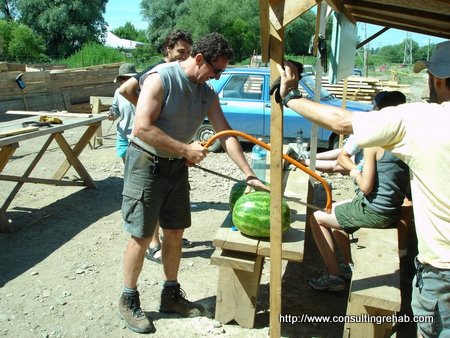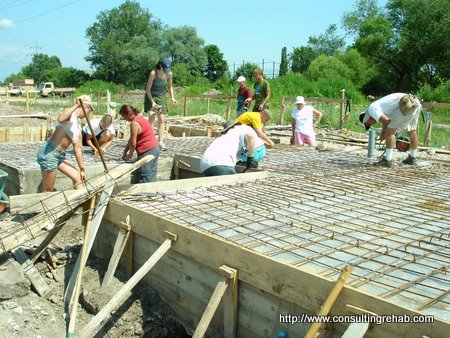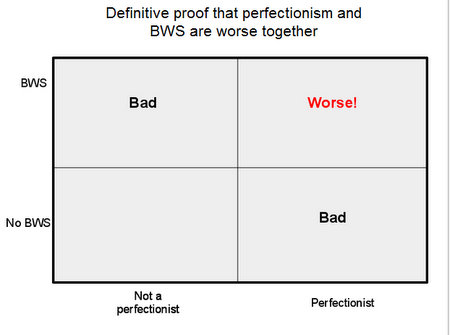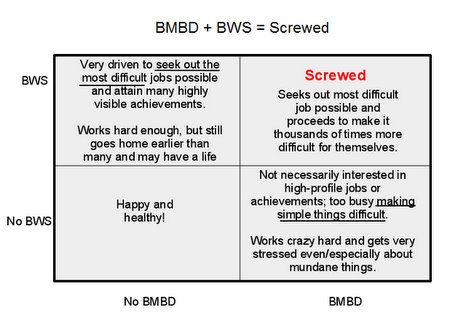We are tired. It’s hard [expletive removed] work trying to inspire all of you people out there to get out and create the life you’ve always wanted rather than the one you think you are supposed to have. We recognize that many of you read this and think, “Wow, that’s really great for them that they are out there having so much fun with no concern for the consequences,” shortly followed by, “That said, they are crazy.” Since we are outnumbered (seriously, there are more of you everyday!), we’ve decided to enlist the help of some other crazy people to help make our point.
As part of our very well thought out and documented blogging strategy (which often involves cocktail napkins and pisco sours), we are officially announcing our new feature “Crazy People That Just Might Inspire You,” or simply CPTJMIY–we even made a fancy logo for it (see above), that’s how serious we are. In CPTJMIY, we will periodically highlight crazy people that have found ways to combine their passions with their daily lives rather than put the pursuit of their passions off until “someday”.
Our first Crazy Person is Dave Kovac
First, a little background on Dave
Dave holds a special place in both of our hearts. Actually, in a very weird coincidence, he was perhaps the first indirect connection between Jen and me and certainly a major catalyst for us having so much to talk about when we first met.
During the summer of 2006 just after I graduated from business school, I had the opportunity to go on a Habitat For Humanity International/Global Village program through the consulting firm that I would soon be working for (they were offering to sponsor this as a sort of sign-on bonus, which was fantastic). I chose a 2-week trip to help build houses in Cluj, Romania–the heart of Transylvania. I had never done anything like this before; it was an amazing experience. Working alongside locals and knowing that you are helping to make a difference for them is so much better than being a tourist–not only do you feel good about helping, but it’s also relatively inexpensive, you do and see things that you’d never be able to experience as a tourist and you get to hang out with a group of pretty awesome fellow volunteers. Why am I telling you this? Dave Kovac was the leader of that trip.
Not only was Dave the leader of my trip in 2006, but he’s been leading trips like this all over the world for years… including the same trip in 2007 at the exact same worksite in Romania that my now-wife Jen went on (you know what they say–a couple that builds the same house together, in Romania, a year apart, with the same trip leader, stays together). So, Dave knew us before we knew us. In an indirect way, he may be responsible for us (which he has mentioned makes him feel a little bit dirty).

... we also played hard. We spent several days exploring the country side with the awesome local staff as our guides. This photo is from a functioning monastery that we spent the night at. It was awesome.
I’ll let Dave tell the rest of his story himself, but one other thing I want to mention… Leading these trips is NOT Dave’s job. Dave does other things for employment and income purposes, but he still makes the time to lead a couple of these trips a year. He is a great example of someone that has found a way to balance passions and responsibilities in a way that perhaps gives him the best of all worlds. Don’t believe me? Let’s ask him:
Note: We’ve split the interview into 2 parts. Part 1, below, focuses mostly on Dave’s involvement with the Habitat for Humanity Global Village program and the kind of amazing experiences you can get from this form of “volunteer vacation.” This is cool stuff and I highly recommend you look into it if you’re looking to do something a little different and extremely rewarding for your next 2 week vacation.
Part 2 of the interview will launch later in the week and will focus more on Dave himself and how he was able to set up his life and career in a way that allows him to spend ~1 month every year somewhere in the world leading trips like this. Very cool stuff.
Dave Kovac – The interview
Dave, how does it feel to be the very first ‘Crazy Person’ featured on Consulting Rehab?
Kind of a weird combination of honored, overjoyed, humbled, and confused. But I’m ready. Bring it.
So let’s talk a little about these Habitat trips you lead…
So, give us the overview–how/when/why did you get into leading these Habitat Global Village trips?
Habitat for Humanity is a great organization. I think a lot of people know that. The Global Village program is Habitat’s international trip program that has really led the way in what has become the volunteer vacation movement. My initial involvement was accidental and during a time in my life when I was in transition — I had been a university administrator and teacher for quite some time and I needed to stop-out of that for the good of our growing family. So when I was in the room when someone received a phone call asking them if they’d be interested in going on a Habitat trip to Kenya, the person who received the call said “No, I don’t think so, but Dave might want to…” And I did.
I had a great experience on that first trip. But it was a little tough. It was in the year 2000 and we would be building the 1,000th Habitat home in Kenya. We didn’t really know that going in, but it became a big deal — dubbed “the Millennium Build.” That put a lot of pressure on our team leader who had to meet with dignitaries, resolve conflicts and disputes arising from villages and communities either vying for our attention or backing-out of previous arrangements, and generally feeling like all of our moves were under some microscope. While being pulled in so many different directions, our team leader asked me to help pay attention to the team and dynamics. All 13 of us were sleeping on a concrete floor under mosquito nets in a 12×13 room, there was no running water, at night we were at the mercy of periodic scheduled and unscheduled rolling blackouts, and during the day we might not even see each other as the team was divided into small groups of 2 or 3 and sent to different work sites (some as far as 90 minutes away) so that different communities could share in the honor of being part of the Millennium Build. I think there ended-up being 6 or 7 Millenium Houses. Separated, in tough conditions, and not knowing what was happening next, people got a little cranky. At the same time, we were all having a fantastic experience — we just need a little time to process it and share in this amazing thing that was happening. So I became the fun guy. It was great! I’d lead massive games of Simon Sez with 30 or 40 village kids each night; we set-up a soccer field in our encampment for evening games; we rented bicycles from the local bike-taxi drivers so we could take an afternoon off to tour the area… We became more engaged in the community. And as we became more engaged in the community we became more committed to the work and began relating to each other better. And I started thinking, “Wow! This happened within days! If I could bottle this up and take it home, think of how enjoyable and productive this could be to our communities, our businesses, and our corporations.”
During the later part of the build, as things were going better and our team really hit our stride, someone suggested I do this sort of thing on a regular basis – that I should lead trips. I was open to the idea but I was hesitant — there wasn’t any money in it and I was a little skeptical about jumping into an organization that I didn’t know too much about. I decided that I’d visit the Habitat headquarters in Americus, Georgia so I could meet some of the people I might be working with and to see if I could honestly support the work they were doing and how they were doing it. Habitat was great. They let me know of a training weekend in Americus, provided me with a place to stay in town — all I had to do was come up with airfare and book a flight. I’m glad I did. I discovered that like anything else, different people have different motivations for being involved in this kind of effort. And that’s OK. I may not be able to recite the spiritual rationale for Habitat’s work, but I can support the outcome. Doing something good is more important than saying something good, and Habitat’s Global Village program is all about doing something good. Once I learned how I could support the effort, it was easy to say “yes.”
How many trips to you lead per year? How long are they?
I average 2 trips a year. Some years I’ll do one, some years I might lead four. Most trips last a little over two weeks — about 17 days when you count travel time, which, for some destinations, can take 4 straight days of travel just to get there. There are a few week-long adventures to locations that are a bit closer to home and don’t take quite as much energy getting to the site. While the trips themselves might last a few weeks, the planning and developing of each trip can take as long as 10 months. And that, for me, is part of what holds my interest — it’s a thread that I use to weave together other facets of my life: the planning, and being intentional about what we try to do helps hold things together for me.
Where have you done trips? Any favorites?
I’ve been to a number of pretty cool spots in Kenya, Mexico, Tanzania, Portugal, Alaska, South Africa, Macedonia, Kyrgyzstan…and then there were the trips to Transylvania (Romania) with you and Jen. I ended up going back to Romania 9 times, I think. As for favorites, I get asked that a lot and end up answering pretty much the same way…it’s hard for me to pick out a single favorite. Each experience has been a little different — a different mix of people, of cultures, of scenery, of work, of conditions — and that mix has made each trip distinctive and special. Those moments kind of meld together into one great uber-memory for me. I have these pictures in my head of driving a bota-bota (bicycle taxi) through a little town in western Kenya while people poured out of their houses to point and laugh; of Habitat families, laborers, and our crew dancing around a tamale truck in Mexico celebrating someone’s birthday; retracing Nelson Mandela’s 11k to Freedom on the 10th anniversary of his release; a soccer match in Portugal in a stadium carved out of an old quarry; peeking outside of a yurt in Kyrgyzstan at the most amazing stars I had ever seen. All of those things are great, but I think what gets me every time is the sincere thanks that I receive from people who truly and sincerely appreciate what little I have done to help them get on with their lives. Most people I’ve come to know as recipients of a Habitat home are terrific, hardworking, wonderful people who have simply become stuck in an unenviable situation. And this little boost helps unstick them. What’s really cool for me is returning to a site that I’ve been to previously and seeing that that little boost really did help. And what’s super-cool is that for those builds I’ve been involved with overseas, there’s a 100% success rate. 1-0-0 PERCENT! Who can say that? Most of us contribute to things/people/causes as an act of faith — we hope that our contributions make a difference. I KNOW my contributions — and the contributions our teams have made — make a difference. And I am reminded of that every time I lead a Global Village trip.
How many and what kind of people go on these trips? (e.g., age, attitude, motivation for going, where they are from, etc.)
Teams can range in size from 8-24. A lot depends on the conditions at the local affiliate where there might be some restrictions on how many people can be transported to and from the worksite, what accommodations are available, how much room is at the project site, etc. Team members can be from anywhere in the world (most are from the US) and there’s an application process that’s facilitated through Habitat’s online web site. Applicants can be specific about when and where they’d like to be considered or they can be fairly general about it. The GV program tries to match potential participants with trips based on availability and interest, then it’s a matter of working with the team leader to make sure there’s a good match with each others’ expectations.
As for motivations of participants, I think that’s all over the map. Someone shared with me a profile of Global Village participants as having certain characteristics, but I haven’t found that profile to fit my teams. I think once you start looking for or targeting certain “types” of people you lose one of the special characteristics of a team which is its diversity. Different people with different motivations having different skills equals a great build experience.
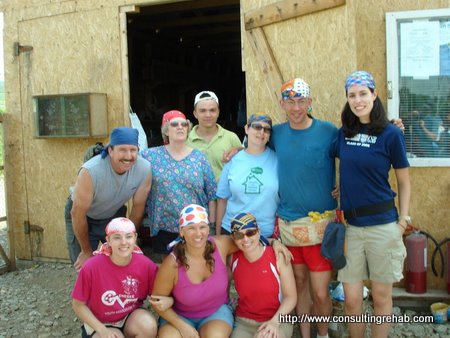
Here's some of the group that I went to Romania with in 2006 - age range spanned ~50 years from youngest to oldest and people were from all over (Our fearless leader, Dave, is the top left)
Can just anyone go (do you need specific skills, background, etc.)?
Just about anyone can join a Global Village team. No construction skills are required — a little flexibility, willingness to learn, a helpful mindset, humor, and a sense of adventure go a long way, though.
What do you think people get out of these trips?
For a lot of people I think that there’s an unexpected sense of appreciation and purpose that comes if they just let it happen. People looking for something specific often don’t find it, or are so intent on finding that one ingredient they miss out on everything else. Not having an agenda actually helps as the experience unfolds. I know, it sounds very karmic. I find, though, that many of us are in jobs and commitments and relationships and activities that don’t seem to have tangible outcomes. We even get judged on those intangibles. What a building a house brings is a tangible set of measures — instant feedback. Combine that sense of accomplishment (even when it’s frustratingly produced) with a continual bombardment of appreciation and thanks, and think of the high that can produce. It’s pure positive feedback — even when it involves digging a hole (which I’ve done on several continents).
Any other marriages resulting from your trips?
Yeah, a few. But I have to warn you, there have also been a few breakups. I had nothing to do with either. Honest.
What do you get out of leading these trips/why do you keep doing it? Any favorite memories?
Besides that high of appreciation and accomplishment, I think what really keeps me involved is how this activity has provided a common thread of purpose through the various fragments of my life. I’m able to relate the experiences of these trips to my other commitments and responsibilities, which often feels fragmented and disconnected. My involvement in Global Village brings continuity to who I am.
Stay tuned for part 2 of this interview later this week to hear more about how Dave manages to balance these trips against family, career, life, etc…
Update: Part 2 is now available here

